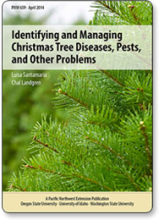Phaeocryptopus gaeumannii
- Parallel rows of tiny, black fruiting bodies on the underside of older needles
- Yellowing or mottling of infected needles
- Loss of interior needles; thin appearance of trees
- Areas with poor air movement
- Field edges near Douglas-fir timber
- Rhabdocline needle cast
- Cooley spruce gall adelgid
- Environmental stresses
- Nutrient imbalances
- Winter burn
- Drought damage
- Using a hand lens, look for parallel bands of tiny, black structures (0.1 mm) arising from the stomates on the undersides of affected needles.
- Start scouting when trees enter their third growing season, beginning in May.
- Look at older needles in the lower part of the tree.
- Pay particular attention to trees that appear off-color or thin.
- Improve air circulation in fields.
- Spray protective fungicides (if needed) between bud break and 3.8 cm of new growth.
- Plant alternative tree species.
- Avoid planting field edges near timber.
- Remove and destroy heavily infected trees prior to bud break.

- Medium susceptibility: Douglas-fir only

- Look for older needles turning yellow, as well as fungal structures: Mid-February through Mid-July
- Check underside of needles for black fruiting bodies: March through Mid-May
- Use fungicides to protect new growth: May through Mid-June


